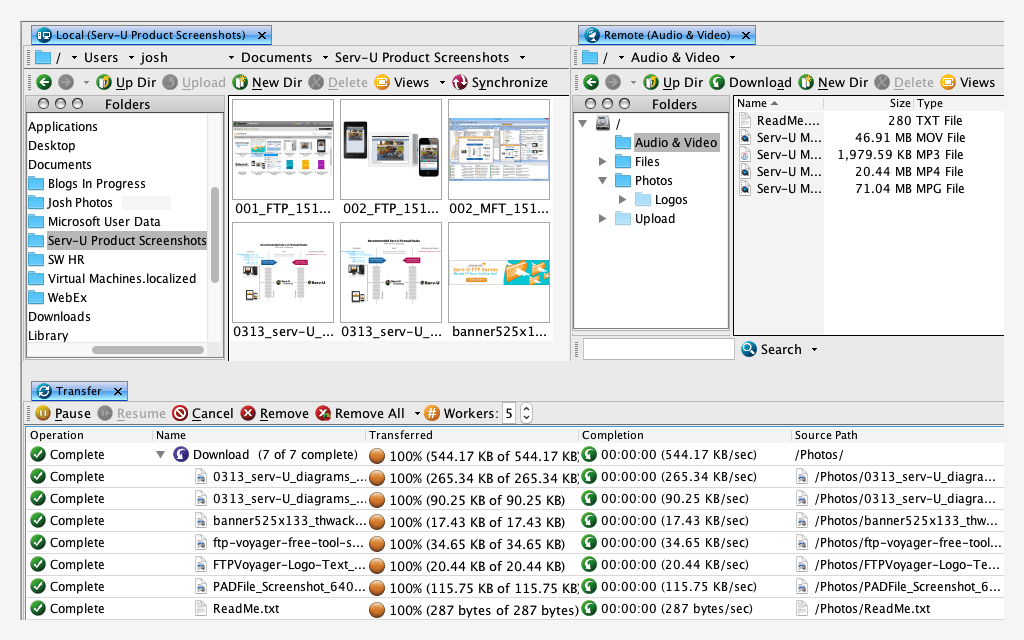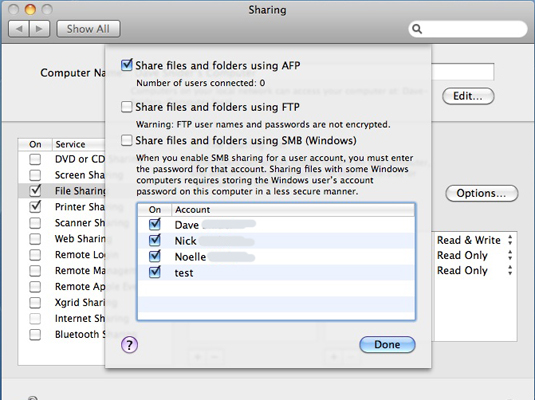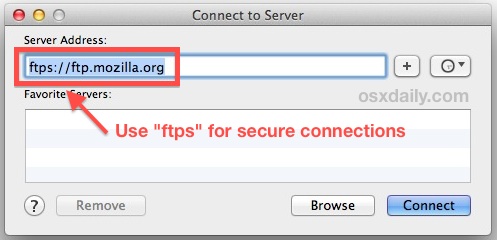Ftp Folder For Mac
By copying files and pasting them into the FTP server's folder, the files will be uploaded to the FTP server. Keep in mind that this only works for servers for which you have permission to upload: Find a file on your Mac. Click the file, then press ⌘ Command + C. Note: Yummy FTP Pro is no longer under development, and it is no longer available for sale. Yummy FTP Pro is an advanced Mac file transfer app which provides a full-featured professional toolkit combined with blazing speeds and impeccable reliability, so whether you want to transfer a few files or a few thousand, schedule backups, edit and maintain websites, even automate transfers, you need.
Ftp://username:[email protected] Now, once connected the 5 most common options are: cd foldername #e.g. Cd /downloads/recent get filename #e.g. Get thisisthefileiwant.text put filename #e.g. Put sendthistotheserver.txt mget filenameregex #e.g mget. to get every file in a directory mput filemameregex #e.g. Mput.txt to upload every txt file to the server. Ftp://username:[email protected] Now, once connected the 5 most common options are: cd foldername #e.g. Cd /downloads/recent get filename #e.g. Get thisisthefileiwant.text put filename #e.g. Put sendthistotheserver.txt mget filenameregex #e.g mget. to get every file in a directory mput filemameregex #e.g. Mput.txt to upload every txt file to the server.
Transmit supports SFTP, you can do it from the command line as well, if you are on another platform such as Windows and you want to SFTP to your Mac, you can use WinSCP or other SFTP free apps. Steps To use the Mac Terminal as an FTP or SFTP Client: 1.The very first thing that you will need is to log in to the FTP or SFTP server using the username and password, if you don’t have any then you should prefer to get the one although FTP can allow you to enter with anonymous username/ password combination. To take security one step further for FTP, FTPS, and SFTP, IT professionals may want to consider implementing third-party tools designed for both FTP for Mac and Windows or enhanced file transfer security available in a managed file transfer (MFT) server tool. This software helps take business security to the next level through a wide variety.
IT professionals looking to use FTP on a Mac must fully understand what FTP is, the risks involved, and the tools available to help them increase efficiencies and keep sensitive information secure.
To understand how to use FTP on a Mac, it’s important to fully grasp what FTP is and how it works. File transfer protocol (FTP) is a method for sending large files across the internet. Many companies rely on FTP sites and tools to operate efficiently on a day-to-day basis, whether to send a multi-slide, image-packed PowerPoint presentation or a high-quality company video. While there are some built-in options for file transfer on a Mac, I’ll also highlight why a robust software program is a better option for just about every business. My recommendation is to check out an option like SolarWinds® Serv-U®.
FTP relies on a client-server relationship in which there’s a separate command channel for controlling files that are uploaded, downloaded, copied, etc., and a data channel for the distribution of the content. These FTP sessions can function in both active and passive modes. With active mode, the client establishes the command channel and the server establishes the data channel. In passive mode, the server uses the command channel to provide the client with the information required to open a data channel, thus putting the client in control of both the command and data channel. Passive mode is often the go-to because it avoids bumping up against firewalls.
Is FTP Secure?
In an era when security threats abound, IT professionals must ensure their companies are upholding security best practices.
FTP used independently, without the support of third-party software, can pose a number of threats. Many FTP sites allow for anonymous transfers, in which users can access and send files without a username and password. Anonymous FTP is not secure and should only be used in situations where files are intended to be public.
But even FTP connections that require an ID and password are at risk. FTP passwords and IDs are transferred over the internet without encryption, potentially exposing them to password sniffing attacks hosted by cybercriminals. Mac FTP clients are also subject to man-in-the-middle attacks, in which attackers alter communications and documents transferred between two computers, often injecting them with malware the recipient then unknowingly downloads.
Another less likely but still possible FTP security risk is data that “strays” to a remote computer rather than its intended destination. This would allow a third party to view or even edit any transferred files, putting confidential information in jeopardy.

Improving FTP Security
To combat this, FTPS (FTP over SSL) was created. FTPS transfers data over an SSL-encrypted network. Any connection attempt that doesn’t use SSL encryption is not accepted by the server. FTPS also leverages digital certificates to authenticate information. Certificates signed by a known certificate authority (CA) or that include a copy of the recipient’s public key are considered secure.
Like FTPS, SFTP (secure file transfer protocol) enhances the security of traditional FTP methodology. Unlike FTPS, which relies on the same data and command channels as FTP, SFTP transfers both data and commands via a single, secure connection. SFTP also encrypts both the authentication information and the data being transferred with the Secure Shell (SSH) protocol, a form of public and private key encryption. This ensures nothing remains as clear text.
To take security one step further for FTP, FTPS, and SFTP, IT professionals may want to consider implementing third-party tools designed for both FTP for Mac and Windows or enhanced file transfer security available in a managed file transfer (MFT) server tool. This software helps take business security to the next level through a wide variety of secure protocols and encryption practices. It can also boost efficiency and streamline many of the clunky side effects associated with basic server FTP functions.
How Can I Use FTP on a Mac?
Using FTP from Mac is straightforward, but there are multiple avenues to consider. There’s a built-in Mac FTP server to make it easy for users to add their files into the FTP client Mac and grant others access to specified documents. To do this, follow these steps:
- Choose “System Preferences” from the Apple icon
- Click “Sharing”
- Select the “File Sharing” box and click “Options”
- Click “Share Files and Folders Using FTP”
Mac Ftp Command Line
Mac Ftp Command
This simple process allows other computers to share and copy files from your machine. If you want to connect to an FTP server Mac to access another individual’s files without third-party software, you’ll need to:
- Navigate to the “Finder Menu”
- Select “Go”
- Click “Connect to Server”
- Enter the name and a password for the server you’re attempting to connect to.
This form of FTP Mac connection comes with a few limitations. It can only be used to download files, and if a username or password contains an “@” symbol, the server will fail to connect. In addition, dragging and dropping large files is typically prohibited and security is at a bare minimum.
Best FTP for Mac Software Options
Ftp Folder For Mac High Sierra
A third-party software, like SolarWinds Serv-U FTP, is needed for IT teams looking to deliver quick, easy, and reliable file transfers from their organization. They’re especially critical for companies that must comply with industry regulations requiring encrypted data transfers, like PCI DSS and HIPPA. The best FTP for Mac software will provide:
- Enhanced Efficiency: Third-party tools can handle large file transfers (>3GB) and enable users to upload or download multiple files at once, avoiding the lag often associated with individual uploads/downloads. Many even boast intuitive web browsers and mobile device interfaces, so you can view, upload, and download documents in very little time from virtually anywhere. Drag-and-drop features and the power to easily add file transfer users and groups further drive efficiency home with these third-party offerings.
- Greater Security: A proper FTP for Mac leverages FTPS protocol for file transfers, encrypting files using SSL or TLS cryptographic protocol, to protect data from accidental exposure or tampering attackers. With these measures, you can rest assured as you send files over both IPv4 and IPv6 networks. This type of software will also ensure no data is stored in the DMZ to comply with PCI and other regulatory frameworks.
- FTP Monitoring and Management: Take things a step further with third-party tools that allow you to monitor file transfer statistics, storage, permissions, access, and more from a real-time, intuitive management console and FTP server log. You can define the limits for the number of sessions on the server, block the IP address of a timed-out session, and enable settings to require reverse DNS names. This bird’s-eye view of activity helps you quickly address any errors or security threats that arise.
- Automation: With tools that offer automation, you can move or delete files after transfer and delete or reset usernames and passwords after a predetermined number of days, all without lifting a finger.

Signing up with third-party software is a must. I recommend SolarWinds Serv-U. These FTP and MFT tools help simplify file transfers, implement critical security protocols, and ensure even your largest files get where they need to go.
Recommended Reading:
Best Remote Support Software in 2020: If you’re looking for remote support software specifically, rather than file transfer functionality, this is the list for you. These are the best 2020 software options for remote troubleshooting, which is a must for most IT professionals these days.
For basic ftp syntax see the main ftp page
This page lists Advanced Options, Cancelling FTP, File Naming Conventions, .netrc file, Command Line Editing, Command Line Prompt and Environment.
The client host with which ftp is to communicate can be specified on the command line. If this is done, ftp will immediately attempt to establish a connection to an FTP server on that host; otherwise, ftp will enter its command interpreter and await instructions from the user. When ftp is awaiting commands from the user the prompt `ftp>' is provided to the user.

To cancel a file transfer, use the terminal interrupt key (usually Ctrl- C). Sending transfers will be immediately halted. Receiving transfers
will be halted by sending an FTP protocol ABOR command to the remote server, and discarding any further data received. The speed at which
this is accomplished depends upon the remote server's support for ABOR processing. If the remote server does not support the ABOR command, the prompt will not appear until the remote server has completed sending the requested file.
If the terminal interrupt key sequence is used whilst ftp is awaiting a reply from the remote server for the ABOR processing, then the connection will be closed. This is different from the traditional behaviour (which ignores the terminal interrupt during this phase), but is considered more useful.
Files specified as arguments to ftp commands are processed according to the following rules.
1. If the file name `-' is specified, the stdin (for reading) or stdout (for writing) is used.
2. If the first character of the file name is `|', the remainder of the argument is interpreted as a shell command. ftp then forks a shell, using popen(3) with the argument supplied, and reads (writes) from the stdout (stdin). If the shell command includes spaces, the argument must be quoted; e.g. `'| ls -lt'. A particularly useful example of this mechanism is: `dir ' |more'.
3. Failing the above checks, if `globbing' is enabled, local file names are expanded according to the rules used in the csh(1); c.f. the glob command. If the ftp command expects a single local file (e.g. put), only the first filename generated by the 'globbing' operation is used.
4. For mget commands and get commands with unspecified local file names, the local filename is the remote filename, which can be altered by a case, ntrans, or nmap setting. The resulting filename can then be altered if runique is on.
5. For mput commands and put commands with unspecified remote file names, the remote filename is the local filename, which can be altered by a ntrans or nmap setting. The resulting filename can then be altered by the remote server if sunique is on.
COMMAND LINE EDITING

ftp supports interactive command line editing, via the editline(3) library. It is enabled with the edit command, and is enabled by default if input is from a tty. Previous lines can be recalled and edited with the arrow keys, and other GNU Emacs-style editing keys can be used as well.
The editline(3) library is configured with a .editrc file - refer to editrc(5) for more information.
An extra key binding is available to ftp to provide context sensitive command and filename completion (including remote file completion). To use this, bind a key to the editline(3) command ftp-complete. By default, this is bound to the TAB key.
Ftp Server Mac Os
Correct execution of many commands depends upon proper behavior by the remote server.
An error in the treatment of carriage returns in the 4.2BSD ascii-mode transfer code has been corrected. This correction can result in incorrect transfers of binary files to and from 4.2BSD servers using the ascii type. Avoid this problem by using the binary image type.
ftp assumes that all IPv4 mapped addresses (IPv6 addresses with a form like ::ffff:10.1.1.1) indicate IPv4 destinations which can be handled by AF_INET sockets. However, in certain IPv6 network configurations, this assumption is not true. In such an environment, IPv4 mapped addresses must be passed to AF_INET6 sockets directly. For example, if your site uses a SIIT translator for IPv6-to-IPv4 translation, ftp is unable to support your configuration.
'Happy is harder than money. Anyone who thinks money will make them happy, doesn't have money ~ David Geffen
Ftp From Mac Terminal
Related macOS commands:

Mac Ftp Server
Ftp Folder For Mac Os
For basic ftp syntax see the main ftp page
getservbyname(3), editrc(5), services(5), ftpd(8)
Some rights reserved
Mac Ftp Software
